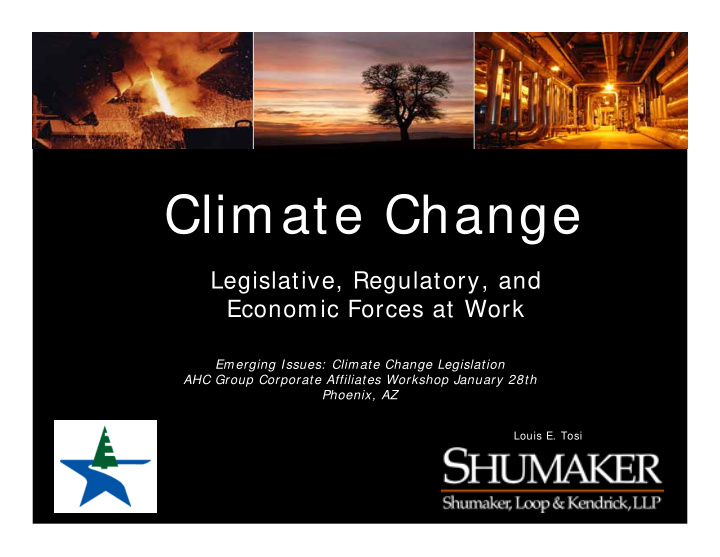



Climate Change Legislative, Regulatory, and Economic Forces at Work Emerging Issues: Climate Change Legislation AHC Group Corporate Affiliates Workshop January 28th Phoenix, AZ Louis E. Tosi
Science Science (closed?) (re-opening?) U.S. Supreme Court (endangerment finding) Public Opinion (changing?) Senate and Climate House Bills Change Action Economic and Physical Impacts Copenhagen New Political Public Opinion Balance
The Climate Change Debate � Whether or not climate change due to anthropogenic activity is a reality or is a debate for the scientific community � In contrast, climate change legislation and policy is a reality that industry will need to address in the upcoming decades
Overview – Competing Legal Drivers � Massachusetts v. EPA � U.S. EPA “endangerment finding” � Congressional legislation � Waxman-Markey GHG bill � Kerry-Boxer GHG bill � International GHG accords � Cost factors
Massachusetts v. EPA (U.S. 2007) � Holding (5-4 decision): GHG could be regulated under CAA 202(a)(1) � “any air pollution agent or combination of such agents, including any physical, chemical … substance or matter which is emitted into or otherwise enters the ambient air” � Implications – Expand Clean Air Act Title V and NSR Programs
EPA Endangerment Finding � Final rule: December 15, 2009 � Six GHG are air pollutants � Carbon dioxide Hydrofluorocarbons � Methane Perfluorocarbons � Nitrous oxide Sulfur hexafluoride � Allows EPA to set emission standards for GHG for new motor vehicles
EPA Endangerment Finding � The next step to stationary sources? � CAA 108(a)(1): “[ T] he Administrator shall … revise … air pollutant – … emissions of which … [ result] from mobile or stationary sources … ” � EPA could avoid a CAA 108 determination for GHG if Congress adopts comprehensive climate change laws (the pressure on legislative action)
GHG Legislation � Waxman-Markey Bill* (H.R.2454): passed House June 26, 2009 by a vote of 219-212 � First comprehensive legislation enacted to limit the growth of GHG � Kerry-Boxer Bill (S.1733): Reported by committee on Nov. 5, 2009 * More comprehensive than Kerry-Boxer Bill
GHG Legislation � Renewable energy standard* � Large utilities must derive a percentage of electricity from renewable energy � 2012: 6% � 2025: 25% � Renewable: Wind, biomass, solar, geothermal, hydropower, landfill gas � Facilities will receive one energy credit for each megawatt of renewable energy � Develop a strategy and regulations for the sequestration of CO 2 * Waxman-Markey Bill Only
GHG Legislation � Regulations to reduce emissions of covered sources to � 97% of 2005 levels by 2012 � 80% of 2005 levels by 2020 � 58% of 2005 levels by 2030 � 17% of 2005 levels by 2050
Net Emission Reductions Under Congress Cap-and-Trade Proposals World Resources Institute.
GHG Legislation � Allows allowance trading (no restrictions, foreign allowances) � Unlimited banking of allowances � May borrow a percentage of future allowances � Strategic reserve allows government to withhold of allowances and auction them off quarterly � No state action; no regulation under Title V, NSR
� Aim of legislation is to reduce average 5.5 tons of carbon per person to 0.63 tons per person
What Would It Take to Achieve these Reductions by 2050? � To achieve these reductions, the U.S. would have to: � Add 30,000 megawatts of new wind turbines every year � Add 35,000 megawatts of solar photovotaic capacity every year � Multiply the nuclear reactor fleet by fivefold � Retrofit all existing coal-fired power plants with carbon capture and storage technology � Build twice as many new plants with carbon capture and storage technology � Substitute natural gas for coal � Require 2/ 3 of cars and trucks to be electricity powered and 1/ 3 run on advanced biofuels R.K. Lester (Dec. 2009). The High Cost of Copenhagen.
The Copenhagen Accord - Toothful or Toothless? � Developed countries agree to provide quantified emission targets for 2020 by January 31, 2010 � Developing countries agree to provide voluntary mitigation actions by January 31, 2010 – No cap � Developed countries agree to create a fund of 100 billion dollars a year by 2020 to address needs of developing countries
China – Reduce Rate of Growth of Emissions � China’s approach: � Economy-wide energy efficiency targets that mandate a reduction in energy intensity � Renewable energy law mandates 16% of energy from wind, biomass, solar, and hydro-power energy by 2020 � Promotes nuclear power � Improve power sector energy efficiency � National building codes � Appliance efficiency standards � Fuel economy standards and motor vehicle taxes � Close inefficient industrial facilities China’s Greenhouse Gas Emissions and Mitigation Policies.
Top Ten CO2 Emitting States 7 0 0 Million Metric Tons CO 2 6 0 0 5 0 0 4 0 0 3 0 0 2 0 0 1 0 0 0 T C P O F I I N M L l n e e l o a l h e i o i d c x n u l i n w r i h o i a n i f i o a s o d i s s Y i g n i r a s y a o a n a l n r n v i a a k a n i a
GHG Legislation Impact on the U.S. GDP Congressional Budget Office (Nov. 2009), The Cost of Reducing Greenhouse-Gas Emissions.
Conclusions � Massachusetts v. EPA opened the door to regulating GHG emissions under the Clean Air Act � The current Administration and Congress are moving forward through various rulemakings and legislation to regulate GHG emissions � These regulations and laws will have an economic impact on the U.S. and will be more detrimental in states that heavily rely on coal- fired power plants for electricity � Stay tuned after Massachusetts election!
Recommend
More recommend